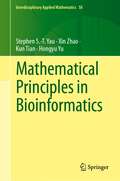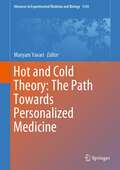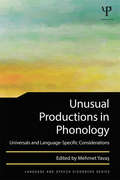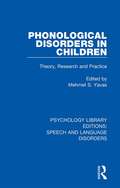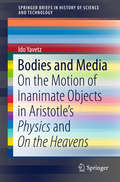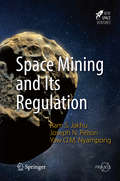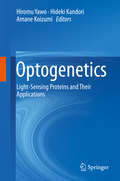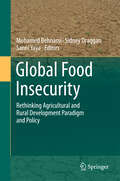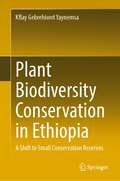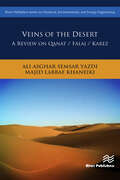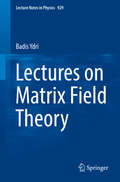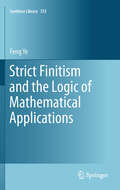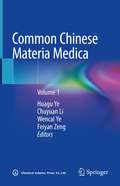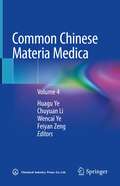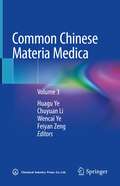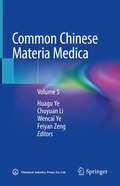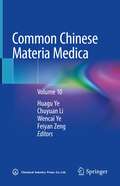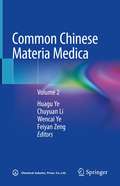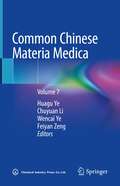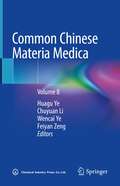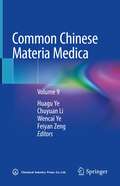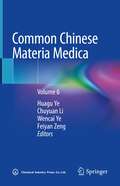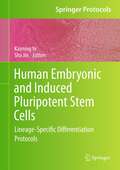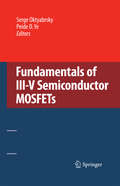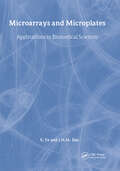- Table View
- List View
Mathematical Principles in Bioinformatics (Interdisciplinary Applied Mathematics #58)
by Stephen S.-T. Yau Xin Zhao Kun Tian Hongyu YuThis textbook introduces bioinformatics to students in mathematics with no biology background assumed and it provides solid mathematical tools for biology students along with an understanding of how to implement them in bioinformatics problems. In addition to the basics, the text offers new approaches to understanding biological sequences. The concise presentation distinguishes itself from others on the subject, discussing and providing principles that relate to current open problems in bioinformatics as well as considering a variety of models. The convex hull principle is highlighted, opening a new interdisciplinary research area at the intersection of biology, mathematics, and computer science. Prerequisites include first courses in linear algebra, probability and statistics, and mathematical analysis. Researchers in mathematics, biology, and math-biology, will also find aspects of this text useful. This textbook is written based on the authors' research works that have been published in various journals along with the lecture notes used when teaching bioinformatics courses at the University of Illinois at Chicago and at Tsinghua University. The content may be divided into two parts. The first part includes three chapters, introducing some basic concepts. Chapter 1 provides biological background in molecular biology for mathematicians. Chapter 2 describes biological databases that are commonly used. Chapter 3 is concerned with alignment methods including global/local alignment, heuristic alignment, and multiple alignment. The second part consisting of five chapters, describes several bioinformatics principles using a rigorous mathematical formulation. Chapter 4 introduces the time-frequency spectral principle and its applications in bioinformatics. In Chapters 5 and 6, two strategies are used, the graphical representation and the natural vector method, to represent biological sequences, and conduct sequence comparison and phylogenetic analysis without alignment. Chapter 7 presents the convex hull principle and shows how it can be used to mathematically determine whether a certain amino acid sequence can be a protein. The last chapter summarizes additional mathematical ideas relating to sequence comparisons, such as new feature vectors and metrics. This part focuses on the governing principle in biology and provides plenty of alignment-free methods, which cannot be found in any other book.
Hot and Cold Theory: The Path Towards Personalized Medicine (Advances in Experimental Medicine and Biology #1343)
by Maryam YavariThis book is about the theory of Hot and Cold, a mutual fundamental base of traditional medicines all around the world. The theory describes the dynamic balance state of the body on the axis of hot and cold for each individual and proposes the fact that deviation from this equilibrium is a predisposing factor for diseases. Such an approach helps practitioners to provide treatments tailored to the patient’s condition, not the disease. This book, for the first time, has gathered native descriptions of Hot and Cold theory in different traditional medicines, including traditional Chinese medicine, Persian (Humoral, Unani) medicine, Ayurvedic medicine and Latin American and Caribbean medicines. After defining the common ground, contemporary research - in nutrition, pharmacology, physiology and systems biology - has been explored using scientific methodology. This work is the result of an international collaboration of more than 30 scientists and scholars with high reputations in their fields. Hot and Cold theory, as a holistic individualized approach in prevention, diagnosis and treatment, can be merged into the novel fast-paced concepts in systems biology and precision medicine. Through this bridge, the authors propose that the Hot and Cold theory should be revisited more deeply by medical scientists, who are the main audience of this book, to pave the way towards integrated holistic personalized medicine.
Unusual Productions in Phonology: Universals and Language-Specific Considerations
by Mehmet YavasThe universalist view that acquisition of phonology is guided by universal principles has been the dominant position for decades. More recently, an alternative view has brought into focus the relationship between developmental markedness and language-specific input frequencies. With entirely original chapters on non-ambient-like productions by typically and atypically developing children, and second language learners, Unusual Productions in Phonology delves deeply into these competing explanations to show that patterns observed do not uniquely lend themselves to one or the other explanations. Rather, they point towards the need for both universal markedness and statistical input considerations in any attempted explanation. Containing contributions from leading researchers from around the world, this impressive collection is a must-have resource for any researcher, practitioner, or advanced student specializing in phonology, cognitive psychology, applied linguistics, and communication disorders.
Phonological Disorders in Children: Theory, Research and Practice (Psychology Library Editions: Speech and Language Disorders)
by Mehmet S. YavasOriginally published in 1991, the recent developments in the study of phonological disorders in children had led to a fruitful interaction between speech pathology and phonology. It is one aspect of the application of linguistic theory to the study of speech and language disorders which had opened up a new field, clinical linguistics. This book brings together the concerns of the linguist and the speech pathologist; the essays chosen share the quality of not discussing theory or therapy without addressing the implications one has for the other. By concentrating on recent work the editor hoped to stimulate further discussion in this important and fast growing area of research.
Bodies and Media: On the Motion of Inanimate Objects in Aristotle’s Physics and On the Heavens (SpringerBriefs in History of Science and Technology)
by Ido YavetzThis book presents a recasting of Aristotle's theory of spatial displacement of inanimate objects. Aristotle's claim that projectiles are actively carried by the media through which they move (such as air or water) is well known and has drawn the attention of commentators from ancient to modern times. What is lacking, however, is a systematic investigation of the consequences of his suggestion that the medium always acts as the direct instrument of locomotion, be it natural or forced, while original movers (e. g. stone throwers, catapults, bowstrings) act indirectly by impressing moving force into the medium. Filling this gap and guided by discussions in Aristotle's Physics and On the Heavens, the present volume shows that Aristotle's active medium enables his theory - in which force is proportional to speed - to account for a large class of phenomena that Newtonian dynamics - in which force is proportional to acceleration - accounts for through the concept of inertia. By applying Aristotle's medium dynamics to projectile flight and to collisions that involve reversal of motion, the book provides detailed examples of the efficacy and coherence that the active medium gives to Aristotle's discussions. The book is directed primarily to historians of ancient, medieval, and early modern science, to philosophers of science and to students of Aristotle's natural philosophy.
Space Mining and Its Regulation
by Yaw Otu Mankata Nyampong Joseph N. Pelton Ram S. JakhuThis book reviews the current and possible future regulatory oversight of the state and non-state actors now engaged in or planning to become engaged in the exploration and possible exploitation of space related natural resources, whether they be liquid, gaseous, or mineral. An increasing number of countries are also becoming involved in space-related activities that were previously carried out primarily by the US and the USSR (now the Russian Federation). The European Union and its individual member states, Japan, China and India in particular are assuming increasingly important roles in space as in many other areas. Even the United Arab Emirates has announced plans to send a future robotic mission to Mars. As such, exploration, exploitation and utilization of space natural resources are no longer matters to be considered within the exclusive domain of competition and decision-making between the US and the Russian Federation. It is significant to note that, in addition to this new international context, the exploitation of space natural resources is also no longer confined to the traditional domains of science and technology. Regulatory issues abound. These endeavors and how they might be regulated by international treaties, standards, codes of conduct or other means have become a truly international political issue. As a consequence, topics dealing with common concerns - sharing of resources, environment protection, and pollution - easily raise difficulties, as they require different states to agree on common principles having a direct impact on their sovereignty and financial interests. There is yet another new paradigm in the conduct of space activities. While in the past, space activities traditionally fell under the exclusive domain of governmental entities, the last few years have seen the emergence of the private sector of "space entrepreneurs". This poses several challenges for the pre-existing governance regime whose foundations are steeped in the classical State-based conception of international law. As a result, the text examines adequacies and ambiguities in treaty provisions and national laws, currently accepted practices involving the exploration and exploitation of space natural resources that will grow in importance in the coming decades.
Optogenetics
by Hiromu Yawo Hideki Kandori Amane KoizumiThe subject of optogenetics is comprehensively covered in this book, including physical, chemical, and biological topics of light-sensing proteins and their application in biological systems, particularly in neuroscience and medicine and the related opto-electronics. Optogenetics is a new technology that combines genetics and optics. It enables one to manipulate or measure the function of identified cells or neurons in a tissue by light with an accuracy in the range of milliseconds, even in a freely moving animal. Optogenetics has already become a powerful tool for revealing the neural mechanisms underlying behavior and analyzing various physiological phenomena. It is also expected to become useful for treating neural dysfunctions such as Parkinson disease and for the development of a brain-machine interface. This book should be read by any scientist or student performing research in any way related to optogenetics. As a milestone publication on optogenetics, this book will serve as a compass for any researcher, from beginners to experts, to explore this uncharted world.
Global Food Insecurity
by Sanni Yaya Mohamed Behnassi Sidney DragganHuman-kind and ecological systems are currently facing one of the toughest challenges: how to feed more billions of people in the future within the perspective of climate change, energy shortages, economic crises and growing competition for the use of renewable and non renewable resources. This challenge is even more crucial given that we have not yet come close to achieving the Millennium Development Goal of halving the number of people living in extreme poverty and hunger. Scientists and relevant stakeholders are now voicing a clear message: that multiple challenges the world is facing require innovative, multifaceted, science-based, technological, economic and political approaches in theoretical thinking, decision making and action. With this background central to survival and well-being, the purpose of this volume is to formulate and promote relevant theoretical analysis and policy recommendations. The major perspective of this publication is that paradigm and policy shifts at all levels are needed urgently. This is based on the evidence that agriculture in the 21st century will be undergoing significant demands, arising largely from the need to increase the global food enterprise, while adjusting and contributing to climate change adaptation and mitigation. Global Food Insecurity aims at providing structure to effect achievement of this critically needed roadmap.
Plant Biodiversity Conservation in Ethiopia: A Shift to Small Conservation Reserves
by Kflay Gebrehiwot YaynemsaThis book covers biodiversity conservation under special consideration of the challenges in the global south with particular attention being paid to consider the existing conservation challenges in relation to the study area in Ethiopia. Key issues are addressed, such as the current and future threats to plant biodiversity in Ethiopia, as well as the single large or several small conservation approaches and which approach is feasible for Ethiopia. Furthermore, an innovative approach was developed that enhances ecological connectivity and promotes ecological restoration through community involvement. The book also covers why a systematic conservation planning approach is important and should be used in new protected area establishments, and also looks at the trends of plant ecology research over the past five decades, revealing research gaps and suggesting future research topics. Despite its focus on Ethiopian plant diversity, abundant examples were used from different continents making this book attractive to global readers. It will be of interest for policy- and decision-makers in the conservation sector, researchers interested in biodiversity, climate change, conservation and sustainable use of natural resources, and would be a valuable resource for university students.
Veins of the Desert: A Review on Qanat / Falaj / Karez
by Ali Asghar Yazdi Majid Labbaf KhaneikiQanat is a gently sloping subterranean canal, which taps a water-bearing zone at a higher elevation than cultivated lands. A qanat consist of a series of vertical shafts in sloping ground, interconnected at the bottom by a tunnel with a gradient flatter than that of the ground. From the air, this system looks like a line of anthills leading from the foothills across the desert to the greenery of an irrigated settlement. Qanat engages a variety of knowledge and its studying entails an interdisciplinary approach. In a traditional realm, qanats are embraced by a socio-economic system which guarantees their sustainability. The facets of this socio-economic system operate closely together and make it possible for the qanats to remain into future.Veins of the Desert shows that digging a qanat requires a variety of sciences and technologies, though at a glance qanat is just a horizontal tunnel which drains out groundwater. Qanat is a feat of technology left from our ancestors; hidden underground, but its technical importance is apparent, not less valuable than such surface structures as bridges, castles, towers, etc. Qanat enjoys extended structures and sometimes its length reaches tens of kilometers. It passes through geological formations and faces different conditions and obstacles, so the qanat masters' efforts to solve these problems led to the accumulation of knowledge in terms of qanat construction over time, which has been handed down from generation to generation. Qanat is one of the most complicated traditional technologies, which require knowledge on nature ranging from groundwater to management. This indigenous technology used to bring water efficiently from tens of kilometers away to the thirsty lands.This book also gives insight into cultural and social heritages, which have crystalized around this technique.
Lectures on Matrix Field Theory
by Badis YdriThese lecture notes provide a systematic introduction to matrix models of quantum field theories with non-commutative and fuzzy geometries. The book initially focuses on the matrix formulation of non-commutative and fuzzy spaces, followed by a description of the non-perturbative treatment of the corresponding field theories. As an example, the phase structure of non-commutative phi-four theory is treated in great detail, with a separate chapter on the multitrace approach. The last chapter offers a general introduction to non-commutative gauge theories, while two appendices round out the text. Primarily written as a self-study guide for postgraduate students - with the aim of pedagogically introducing them to key analytical and numerical tools, as well as useful physical models in applications - these lecture notes will also benefit experienced researchers by providing a reference guide to the fundamentals of non-commutative field theory with an emphasis on matrix models and fuzzy geometries.
Strict Finitism and the Logic of Mathematical Applications
by Feng YeThis book intends to show that radical naturalism (or physicalism), nominalism and strict finitism account for the applications of classical mathematics in current scientific theories. The applied mathematical theories developed in the book include the basics of calculus, metric space theory, complex analysis, Lebesgue integration, Hilbert spaces, and semi-Riemann geometry (sufficient for the applications in classical quantum mechanics and general relativity). The fact that so much applied mathematics can be developed within such a weak, strictly finitistic system, is surprising in itself. It also shows that the applications of those classical theories to the finite physical world can be translated into the applications of strict finitism, which demonstrates the applicability of those classical theories without assuming the literal truth of those theories or the reality of infinity. Both professional researchers and students of philosophy of mathematics will benefit greatly from reading this book.
Common Chinese Materia Medica: Volume 1
by Huagu Ye Chuyuan Li Wencai Ye Feiyan ZengThis first volume describes 78 species of medicinal plants in 44 families, in which 7 families and 13 species are algae and fungi, 28 families and 52 species are ferns, 9 families and 13 species are gymnosperms. The algae include Laminaria japonica, Sargassum fusiforme, Ulva lactucam, Uiva pertusa et al.; the fungi include Calvatia lilacina, Calvatia lilacina, Cordyceps sobolifera, et al.; the gymnosperms include Ginkgo biloba, Pinus massoniana, Thuja orientalis, Ephedra sinica, Ephedra intermedia, Ephedra equisetina, et al. In each specie, it introduces the scientific names, herbal medicine names, characteristics, habitats, distributions, Acquisition and processing methods, medicinal traits, tastes, functions, use and dosages, and other information of medicinal plants. The color pictures of all species in their wild forms are presented, along with some pictures of medicinal products made of them. This book series has totally 10 volumes, which covers 2000 kinds of Chinese medicines that are commonly seen or used. These volumes not only introduce the efficacy function and some prescriptions of the medicines, but also introduce the biological characteristics of them in detail with clear photos of the habitats, so that readers can identify them in the field. Apart from the growing environment, the books expound the distribution areas and other information to facilitate researches and other applications. The volumes are targeted at readers of general interests and it is also of high referential value for scientific researcher and teachers. It can be used as a guide to researchers, clinical doctors, and students in the department of pharmaceutics and traditional Chinese medicine.
Common Chinese Materia Medica: Volume 4
by Huagu Ye Chuyuan Li Wencai Ye Feiyan ZengThis fourth volume describes 256 species of medicinal plants from 5 families, which are commonly used in Chinese medicine. The most important species are Agrimonia pilosa, Amygdalus persica, Armeniaca mume, Armeniaca vulgaris, Armeniaca sibirica, Chaenomeles sinensis, Eriobotrya japonica of Rosaceae; Chimonanthus praecox of Calycanthaceae;Albizia julibrissin, Archidendron clypearia, Entada phaseoloides, Bauhinia championii of Mimosoideae; Caesalpinia sappan, Cassia tora, Gleditsia sinensis of Caesalpiniaceae; Abrus cantoniensis, Astragalus membranaceus, Astragalus membranaceus, Dalbergia odorifera, Desmodium caudatum, Desmodium styracifolium, Erythrina variegata, Euchresta japonica, Flemingia prostrata, Glycyrrhiza uralensis, Glycyrrhiza inflata, Glycyrrhiza glabra, Lablab purpureus, Sophora japonica and Spatholobus suberectus of Butterflyaceae. In each specie, it introduces the scientific names, medicinal names, morphologies, habitats, distributions, acquisition and processing methods of these medicinal plants, the content of medicinal properties, therapeutic effects, usage and dosage of these medicinal plants, and attaches unedited color pictures and pictures of part herbal medicines of each species. This book series has 10 volumes in total, which covers over 2000 kinds of Chinese medicines that are commonly used. These volumes not only introduce the efficacy function and some prescriptions of the medicines, but also introduce the biological characteristics of them in detail with clear photos of the habitats, so that readers can identify them in the field. Apart from the growing environment, the books expound the distribution areas and other information to facilitate researches and other applications. The volumes are targeted at readers of general interests and it is also of high referential value for scientific researcher and teachers. It can be used as a guide to researchers, clinical doctors, and students in the department of pharmaceutics and traditional Chinese medicine.
Common Chinese Materia Medica: Volume 3
by Huagu Ye Chuyuan Li Wencai Ye Feiyan ZengThis third volume describes 226 species of 32 families of medicinal plants, which are commonly used in Chinese medicine. The most important species are Aquilaria sinensis and Daphne genkwa of Thymelaeaceae; Benincasa hispida, Siraitia grosvenorii, Trichosanthes kirilowii and Trichosanthes rosthornii of Cucurbitaceae; Camellia sinensis of Theaceae; Cleistocalyx operculatus, Eugenia caryophyllata and Rhodomyrtus tomentosa of Myrtaceae; Osbeckia chinensis of Melastomataceae; Quisqualis indica and Terminalia chebula of Combretaceae; Hypericum japonicum of Hypericaceae; Microcos paniculata of Tiliaceae; Hibiscus mutabilis of Malvaceae; Croton crassifolius, C. lachnocarpus, C. tiglium, Euphorbia humifusa, E. lathyris, E. pekinensis, Phyllanthus emblica and Sauropus spatulifolius of Euphorbiaceae. In each specie, it introduces the scientific names, medicinal names, morphologies, habitats, distributions, acquisition and processing methods of these medicinal plants, the content of medicinal properties, therapeutic effects, usage and dosage of these medicinal plants, and attaches unedited color pictures and pictures of part herbal medicines of each species.This book series has 10 volumes in total, which covers over 2000 kinds of Chinese medicines that are commonly used. These volumes not only introduce the efficacy function and some prescriptions of the medicines, but also introduce the biological characteristics of them in detail with clear photos of the habitats, so that readers can identify them in the field. Apart from the growing environment, the books expound the distribution areas and other information to facilitate researches and other applications. The volumes are targeted at readers of general interests and it is also of high referential value for scientific researcher and teachers. It can be used as a guide to researchers, clinical doctors, and students in the department of pharmaceutics and traditional Chinese medicine.
Common Chinese Materia Medica: Volume 5
by Huagu Ye Chuyuan Li Wencai Ye Feiyan ZengThis fifth volume contains 253 species of medicinal plants from 25 families, which are commonly used in Chinese medicine. The most important species are Stachyurus himalaicus of Stachyuraceae; Liquidambar formosana, Semiliquidambar cathayensis of Hamamelidaceae; Broussonetia papyrifera, Cudrania cochinchinensis, Cudrania tricuspidata, Ficus carica, Morus alba of Moraceae; Boehmeria nivea and Pouzolzia zeylanica of Urticaceae; Cannabis sativa of Cannabaceae; Ilex asprella, Ilex cornuta, Ilex latifolia, Ilex pubescens of Aquifoliaceae; Euonymus alatus, Tripterygium wilfordii of Celastraceae; Taxillus chinensis, Viscum liquidambaricola of Loranthaceae; Santalum album of Santalaceae; Berchemia lineata, Ventilago leiocarpa, Ziziphus jujuba, Ziziphus jujuba var. Spinosa, Elaeagnus pungens of Rhamnaceae; Citrus aurantium, Citrus grandis var. tomentosa, Citrus medica var. sarcodactylis, Citrus reticulata, Evodia rutaecarpa, Phellodendron chinense and Zanthoxylum bungeanum of Rutaceae. In each specie, it introduces the scientific names, medicinal names, morphologies, habitats, distributions, acquisition and processing methods of these medicinal plants, the content of medicinal properties, therapeutic effects, usage and dosage of these medicinal plants, and attaches unedited color pictures and pictures of part herbal medicines of each species. This book series has 10 volumes in total, which covers over 2000 kinds of Chinese medicines that are commonly used. These volumes not only introduce the efficacy function and some prescriptions of the medicines, but also introduce the biological characteristics of them in detail with clear photos of the habitats, so that readers can identify them in the field. Apart from the growing environment, the books expound the distribution areas and other information to facilitate researches and other applications. The volumes are targeted at readers of general interests and it is also of high referential value for scientific researcher and teachers. It can be used as a guide to researchers, clinical doctors, and students in the department of pharmaceutics and traditional Chinese medicine.
Common Chinese Materia Medica: Volume 10
by Huagu Ye Chuyuan Li Wencai Ye Feiyan ZengThis tenth volume records 5 species of resin, 74 species of animals, 41 species of minerals and fossils. There are resins such as Liquidambar orientalis, Commiphore myrrha, Boswellia carterii, Garcinia hanburyi; animals such as Solenognathus hardwickii, , Cervus nippon, Scolopendra subspinipes, Cryptotympana pustulata, Agkistrodon acutus, Bombyx mori, Collocalia esculenta, Moschus moschiferus, Hippocampus kelloggi, Gekko gekko; minerals and fossils such as mercury, gypsum, alum, mirabilite, cinnabar, actinolite, calomel, keel, dens draconis, lithodes, fossilia spiriferis. In each specie, it introduces the scientific names, medicinal names, morphologies, habitats, distributions, acquisition and processing methods of these medicinal plants, the content of medicinal properties, therapeutic effects, usage and dosage of these medicinal plants, and attaches unedited color pictures and pictures of part herbal medicines of each species. This book series has 10 volumes in total, which covers over 2000 kinds of Chinese medicines that are commonly used. These volumes not only introduce the efficacy function and some prescriptions of the medicines, but also introduce the biological characteristics of them in detail with clear photos of the habitats, so that readers can identify them in the field. Apart from the growing environment, the books expound the distribution areas and other information to facilitate researches and other applications. The volumes are targeted at readers of general interests and it is also of high referential value for scientific researcher and teachers. It can be used as a guide to researchers, clinical doctors, and students in the department of pharmaceutics and traditional Chinese medicine.
Common Chinese Materia Medica: Volume 2
by Huagu Ye Chuyuan Li Wencai Ye Feiyan ZengThis second volume contains 231 species of 40 families of medicinal plants. The most important family of which are Magnoliaceae, such as Magnolia officinalis and Magnolia officinalis subsp. biloba; Schisandra chinensis of Schisandraceae; Cinnamomum aromaticum of Lauraceae, Coptis chinensis Franch., Coptis omeiensis and Coptis teeta of Berberidaceae; Isatis indigotica, Lepidium apetalum and Raphanus sativus of Cruciferae; Rheum palmatum, Rheum officinale and Rheum taguticum of Polygonaceae, etc. In each specie, it introduces the scientific names, herbal medicine names, characteristics, habitats, distributions, Acquisition and processing methods, medicinal traits, tastes, functions, use and dosages, and other information of medicinal plants. The color pictures of all species in their wild forms are presented, along with some pictures of medicinal products made of them. This book series has totally 10 volumes, which covers 2000 kinds of Chinese medicines that are commonly seen or used. These volumes not only introduce the efficacy function and some prescriptions of the medicines, but also introduce the biological characteristics of them in detail with clear photos of the habitats, so that readers can identify them in the field. Apart from the growing environment, the books expound the distribution areas and other information to facilitate researches and other applications. The volumes are targeted at readers of general interests and it is also of high referential value for scientific researcher and teachers. It can be used as a guide to researchers, clinical doctors, and students in the department of pharmaceutics and traditional Chinese medicine.
Common Chinese Materia Medica: Volume 7
by Huagu Ye Chuyuan Li Wencai Ye Feiyan ZengThis seventh volume describes 247 species of 9 families of medicinal plants, which are commonly used in Chinese medicine. The most important species are Adina rubella, Gardenia jasminoides, Hedyotis diffusa, Morinda officinalis, Rubia cordifolia, Uncaria hirsuta, Uncaria macrophylla, Uncaria rhynchophylla, Uncaria sessilifructus, Uncaria sinensis of Rubiaceae; Lonicera confusa, Lonicera hypoglauca, Lonicera macranthoides, Lonicera japonica of Caprifoliaceae; Patrinia scabiosaefolia, Patrinia villosa, Nardostachys jatamansi of Valerianaceae; Dipsacus asperoides of Dipsacaceae; Arctium lappa, Artemisia annua, Artemisia argyi, Artemisia capillaris, Artemisia scoparia, Atractylodes lancea, Atractylodes macrocephala, Dendranthema indicum, Dendranthema morifolium, Eupatorium chinense, Eupatorium fortunei, Inula helenium, Saussurea costus, Saussurea involucrata, Senecio scandens, Serratula chinensis, Siegesbeckia orientalis, Solidago decurrens, Taraxacum mongolicum, Tussilago farfara、Xanthium sibiricum of Compositae; Gentiana crassicaulis, Gentiana manshurica, Gentiana rigescens, Gentiana scabra, Swertia pseudochinensis of Valerianaceae; Lysimachia christinae of Primulaceae and Plantago asiatica of Plantaginaceae. In each specie, it introduces the scientific names, medicinal names, morphologies, habitats, distributions, acquisition and processing methods of these medicinal plants, the content of medicinal properties, therapeutic effects, usage and dosage of these medicinal plants, and attaches unedited color pictures and pictures of part herbal medicines of each species. This book series has 10 volumes in total, which covers over 2000 kinds of Chinese medicines that are commonly used. These volumes not only introduce the efficacy function and some prescriptions of the medicines, but also introduce the biological characteristics of them in detail with clear photos of the habitats, so that readers can identify them in the field. Apart from the growing environment, the books expound the distribution areas and other information to facilitate researches and other applications. The volumes are targeted at readers of general interests and it is also of high referential value for scientific researcher and teachers. It can be used as a guide to researchers, clinical doctors, and students in the department of pharmaceutics and traditional Chinese medicine.
Common Chinese Materia Medica: Volume 8
by Huagu Ye Chuyuan Li Wencai Ye Feiyan ZengThis eighth volume describes 272 species of 13 families of medicinal plants, which are commonly used in Chinese medicine. The most important species are Adenophora stricta, Adenophora tetraphylla, Codonopsis pilosula, Codonopsis tangshen and Platycodon grandiflorus of Campanulaceae; Lobelia chinensis of Lobeliaceae; Hyoscyamus niger, Lycium barbarum and Lycium ruthenicum of Solanaceae; Cuscuta australis, Cuscuta chinensis, Erycibe obtusifolia of Convolvulaceae; Lagotis brevituba, Rehmannia glutinosa, Scrophularia ningpoensis of Scrpophulariaceae; Aeginetia indica, Cistanche deserticola, Cistanche of Orobanchaceae; Campsis grandiflora, Oroxylum indicum of Bignoniaceae; Andrographis paniculata, Strobilanthes cusia of Acanthaceae; Callicarpa formosana, Callicarpa kwangtungensis, Clerodendrum cyrtophyllum, Clerodendrum fortunatum, Verbena officinalis, Vitex trifolia of Verbenaceae; Agastache rugosa, Ajuga decumbens, Clerodendranthus spicatus, Clinopodium chinense, Glechoma longituba, Lamiophlomis rotata, Leonurus japonicus, Lycopus lucidus var. Hirtus, Mesona chinensis, Perilla frutescens, Pogostemon cablin, Prunella vulgaris, Salvia bowleyana, Salvia miltiorrhiza, Schizonepeta tenuifolia, Scutellaria baicalensis of Lamiaceae. In each specie, it introduces the scientific names, medicinal names, morphologies, habitats, distributions, acquisition and processing methods of these medicinal plants, the content of medicinal properties, therapeutic effects, usage and dosage of these medicinal plants, and attaches unedited color pictures and pictures of part herbal medicines of each species. This book series has 10 volumes in total, which covers over 2000 kinds of Chinese medicines that are commonly used. These volumes not only introduce the efficacy function and some prescriptions of the medicines, but also introduce the biological characteristics of them in detail with clear photos of the habitats, so that readers can identify them in the field. Apart from the growing environment, the books expound the distribution areas and other information to facilitate researches and other applications. The volumes are targeted at readers of general interests and it is also of high referential value for scientific researcher and teachers. It can be used as a guide to researchers, clinical doctors, and students in the department of pharmaceutics and traditional Chinese medicine.
Common Chinese Materia Medica: Volume 9
by Huagu Ye Chuyuan Li Wencai Ye Feiyan ZengThis ninth volume describes 285 species of medicinal plants of 30 families, which are commonly used in Chinese medicine. The most important species are Alisma orientale of Alismaceae; Commelina communis of Commelinaceae; Eriocaulon buergerianum of Eriocaulaceae; Alpinia galanga, Alpinia hainanensis, Alpinia officinarum, Alpinia oxyphylla, Amomum compactum, Amomum kravanh, Amomum villosum, Amomum villosum var. xanthioides, Amomum longiligulare, Amomum tsao-ko, Costus speciosus, Curcuma aromatica, Curcuma kwangsiensis, Kaempferia galanga, Zingiber officinale of Zingiberaceae; Anemarrhena asphodeloides, Asparagus cochinchinensis, Disporum cantoniense, Fritillaria cirrhosa, Fritillaria delavayi, Fritillaria unibracteata, Lilium brownii, Lilium brownii, Liriope muscari, Ophiopogon japonicus, Polygonatum kingianum, Polygonatum sibiricum, Polygonatum odoratum of Liliaceae; Paris polyphylla of Trilliaceae; Smilax glabra and Smilax riparia of Smilacaceae;Acorus calamus, Acorus tatarinowii, Aglaonema modestum, Alocasia macrorrhiza, Arisaema amurense, Homalomena occulta, Lasia spinosa, Pinellia pedatisecta, Pinellia ternata, Pistia stratiotes, Typhonium giganteum of Araceae; Sparganium stoloniferum of Sparganiaceae; Typha angustifolia of Typhaceae; Allium chinense , Allium sativum, Allium tuberosum of Amaryllidaceae; Crocus sativus, Belamcanda chinensis of Iridaceae; Dioscorea opposita of Dioscoreaceae; Areca catechu of Palmae; Bletilla striata, Dendrobium aduncum, Dendrobium loddigesii, Dendrobium nobile, Dendrobium officinale, Gastrodia elata of Orchidaceae; Juncus effusus of Juncaceae; Cyperus rotundus of Cyperaceae; Coix lacryma-jobi var. ma-yuen of Gramineae. In each specie, it introduces the scientific names, medicinal names, morphologies, habitats, distributions, acquisition and processing methods of these medicinal plants, the content of medicinal properties, therapeutic effects, usage and dosage of these medicinal plants, and attaches unedited color pictures and pictures of part herbal medicines of each species. This book series has 10 volumes in total, which covers over 2000 kinds of Chinese medicines that are commonly used. These volumes not only introduce the efficacy function and some prescriptions of the medicines, but also introduce the biological characteristics of them in detail with clear photos of the habitats, so that readers can identify them in the field. Apart from the growing environment, the books expound the distribution areas and other information to facilitate researches and other applications. The volumes are targeted at readers of general interests and it is also of high referential value for scientific researcher and teachers. It can be used as a guide to researchers, clinical doctors, and students in the department of pharmaceutics and traditional Chinese medicine.
Common Chinese Materia Medica: Volume 6
by Huagu Ye Chuyuan Li Wencai Ye Feiyan ZengThis sixth volume describes 226 species of 32 families of medicinal plants, which are commonly used in Chinese medicine. The most important species are Aquilaria sinensis and Daphne genkwa of Thymelaeaceae; Benincasa hispida, Siraitia grosvenorii, Trichosanthes kirilowii and Trichosanthes rosthornii of Cucurbitaceae; Camellia sinensis of Theaceae; Cleistocalyx operculatus, Eugenia caryophyllata and Rhodomyrtus tomentosa of Myrtaceae; Osbeckia chinensis of Melastomataceae; Quisqualis indica and Terminalia chebula of Combretaceae; Hypericum japonicum of Hypericaceae; Microcos paniculata of Tiliaceae; Hibiscus mutabilis of Malvaceae; Croton crassifolius, C. lachnocarpus, C. tiglium, Euphorbia humifusa, E. lathyris, E. pekinensis, Phyllanthus emblica and Sauropus spatulifolius of Euphorbiaceae. In each specie, it introduces the scientific names, medicinal names, morphologies, habitats, distributions, acquisition and processing methods of these medicinal plants, the content of medicinal properties, therapeutic effects, usage and dosage of these medicinal plants, and attaches unedited color pictures and pictures of part herbal medicines of each species.This book series has 10 volumes in total, which covers over 2000 kinds of Chinese medicines that are commonly used. These volumes not only introduce the efficacy function and some prescriptions of the medicines, but also introduce the biological characteristics of them in detail with clear photos of the habitats, so that readers can identify them in the field. Apart from the growing environment, the books expound the distribution areas and other information to facilitate researches and other applications. The volumes are targeted at readers of general interests and it is also of high referential value for scientific researcher and teachers. It can be used as a guide to researchers, clinical doctors, and students in the department of pharmaceutics and traditional Chinese medicine.
Human Embryonic and Induced Pluripotent Stem Cells
by Kaiming Ye Sha JinBecause of the huge potential of human embryonic stem (hES) cells, especially the newly developed human induced pluripotent stem (hiPS) cells, in disease treatment and life quality improvement, enormous efforts have been made to develop new methodologies to translate lab discoveries in stem cell research into bed-side clinical technologies. In Human Embryonic and Induced Pluripotent Stem Cells: Lineage-Specific Differentiation Protocols, experts in the field present a comprehensive collection of protocols designed for labs around the world. The topics covered in this detailed volume include techniques used for maintenance of hES and iPS cells in either small or large scale, techniques for directing hES and iPS cell lineage specification, techniques for enhancing the maturity of differentiated hES and iPS cells within three-dimensional scaffolds, techniques for reprogramming adult cells into iPS cells, techniques for generating patient-specific iPS cells, and techniques for translating hES and iPS cell research into new therapies. Chapters include lab ready protocols with tips on troubleshooting and avoiding known pitfalls. Wide-ranging and authoritative, Human Embryonic and Induced Pluripotent Stem Cells: Lineage-Specific Differentiation Protocols will be a tremendous aid for researchers and students who wish to explore these areas and transform their discoveries into the next generation of regenerative medicine and tissue engineering technologies.
Fundamentals of III-V Semiconductor MOSFETs
by Peide Ye Serge OktyabrskyFundamentals of III-V Semiconductor MOSFETs presents the fundamentals and current status of research of compound semiconductor metal-oxide-semiconductor field-effect transistors (MOSFETs) that are envisioned as a future replacement of silicon in digital circuits. The material covered begins with a review of specific properties of III-V semiconductors and available technologies making them attractive to MOSFET technology, such as band-engineered heterostructures, effect of strain, nanoscale control during epitaxial growth. Due to the lack of thermodynamically stable native oxides on III-V's (such as SiO2 on Si), high-k oxides are the natural choice of dielectrics for III-V MOSFETs. The key challenge of the III-V MOSFET technology is a high-quality, thermodynamically stable gate dielectric that passivates the interface states, similar to SiO2 on Si. Several chapters give a detailed description of materials science and electronic behavior of various dielectrics and related interfaces, as well as physics of fabricated devices and MOSFET fabrication technologies. Topics also include recent progress and understanding of various materials systems; specific issues for electrical measurement of gate stacks and FETs with low and wide bandgap channels and high interface trap density; possible paths of integration of different semiconductor materials on Si platform.
Microarrays and Microplates: Applications in Biomedical Sciences (Advanced Methods Ser.)
by S. Ye I.N.M. DayThe 'Advanced Methods' series is intended for advanced undergraduates, postgraduates and established research scientists. Titles in the series are designed to cover current important areas of research in life sciences, and include both theoretical background and detailed protocols. The aim is to give researchers sufficient theory, supported by references, to take the given protocols and adapt them to their particular experimental systems.Microarrays and Microplates title looks at the new microarray and microplate-based technologies which facilitate large-scale analysis of DNA sequence variants, mRNA molecules and proteins. The book provides a review of the various methodologies being used to identify genetic variants and gene regulation and guides readers through both the application of these methodologies and experimental procedures.
